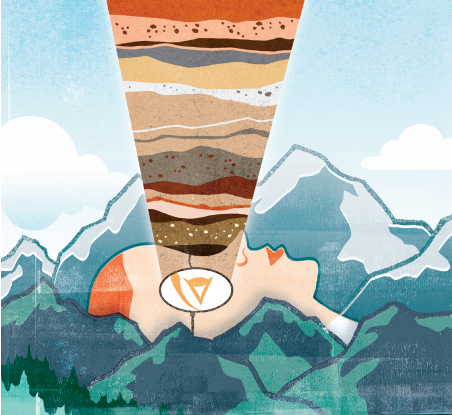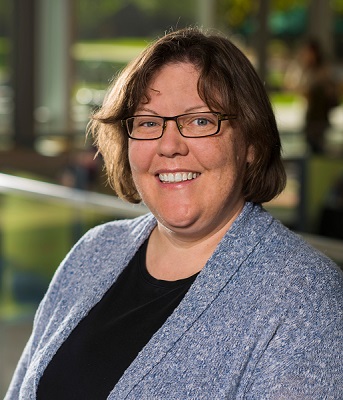
Illustration by Blair Kelly.
What can Earth's past tell us about our potential future? How do we safely and efficiently power a growing world? When natural disaster strikes, how can we ensure our environment and communities are protected?
To tackle some of the world's most pressing questions, it takes outstanding research, active collaboration, and exceptional graduates prepared to take up the gauntlet and advance confidently into the future of our planet-and beyond. Home to a robust and diverse research program as well as the nation's preeminent geophysics program, the Faculty of Science is well positioned to answer the call.
A highly interdisciplinary field at the intersection of physics and Earth and planetary sciences, geophysics research explores areas as broad and deep as Earth itself. Though associated most often with the oil and gas industry, geophysicists today work in myriad industries, from economic mineral exploration and geothermal energy assessment to groundwater and archaeological studies and environmental contamination monitoring.
"Our geophysics group has people working on both applied and global geophysics," says Mauricio Sacchi, geophysicist and chair of the Department of Physics. The graduate program is diverse, with students investigating imaging methodologies for high-resolution prospecting of oil and gas, students investigating hydraulic fracturing, and students working on geodynamics of Earth's lithosphere, mantle, and core. In the geodynamics group, students are also studying planetary dynamics and magnetic fields of Earth and planets such as Jupiter.
Not your parent's geophysics
Applications of geophysics also continue to grow and diversify, as global attention turns to climate change and other emerging issues.
Geophysical methods are now being used in a variety of novel applications. "Recently, geophysical methods have also been applied in other areas, such as checking the integrity of concrete buildings and bridges, and even in the medical industry where seismology techniques developed for oil exploration are now being used to image bone structure," says Claire Currie (physics). "I know several geophysicists who have gone on to careers in the banking and insurance industries, where they are making use of their background in analyzing time-dependent data and understanding natural hazards."
An evolving field requires nimble graduates, equipped with the knowledge and skills to tackle big problems in innovative ways.
Unlike most geophysics programs, which are typically based in Earth sciences departments, the University of Alberta's program is positioned in the Department of Physics. This small but key distinction provides students an extra edge in quantitative areas-physics, math, and computer programming-in addition to their fundamental geophysics and geology courses. "Today, datasets are large," says Sacchi. "Geophysicists also learn methods in numerical analysis and computational physics, making computer programming a significant part of the job."
Accordingly, students graduate with a highly versatile skill set, with benefits they can take to the field and far beyond.
Out to field
At the heart of the program is GEOPH 436, the geophysics field school. Available to both undergraduate and graduate students, the field school is typically taken at the start of the fourth year of the undergraduate program, when students take the techniques they've learned so far and apply them in the field.
"At this point, students have learned the basics of the key geophysical techniques," says Currie. "However, learning about a technique from lectures and demonstrations in class is very different from actually collecting data in the field. Each of these steps requires careful planning, and I think that students then realize how much effort goes into getting a good data set."
In the field, students are responsible for designing geophysical surveys, setting up the instrumentation, collecting the data, and then processing the data to generate images of the subsurface structures.
Teamwork is also a key part of the experience. Through a series of group projects, students learn to work collaboratively with classmates with all different types of personalities and academic and cultural backgrounds.
For most students, it is their first time collecting data in a real outdoor setting. "The field school is a real field, so we have a lot of small challenges-they learn more than just geophysics," explains Vadim Kravchinsky (physics), the primary instructor for the course.
An essential experience
From the perspective of geophysics alumna Cassandra Budd ('10 BSc, '11 BSc), now a project geophysicist with an engineering consulting firm, the field school experience is indispensable to the program. "It's a taste of how this is actually done. It's a chance to apply all these theories that you've learned about in class and really begin to appreciate that what works out perfectly in a textbook doesn't always work out perfectly in the field."
The term culminates with an oral presentation and poster session in which the students present and defend their results to a committee of faculty members and industry representatives.
"In most courses, the students write midterms, they write final exams, but in this course, they have to be verbal," says Kravchinsky. "They need to present their oral presentation well, and they need to answer questions from committee members. They learn a lot."
The one week spent in the field is just a small portion of the field school experience as a whole, which is woven deeply throughout the geophysics curriculum at all levels.
"All geophysics-related courses-from the first year to the fourth year-are interconnected," explains Kravchinsky. "In their first and second years, students learn the fundamental physics, math, and computational techniques used in geophysics. In the third year, these are applied to learn how to analyze and process geophysical data, and students work with geophysics data in the lab-writing codes and analyzing the data with computers. Then in their fourth year, students collect their own data for themselves and other students to study, and they complete a full analysis.
"They've used some of this data before, so when they come to the field school, they already know what to expect."
Funded exclusively through philanthropic donations, the field school is exceptionally vulnerable to economic fluctuations. With lingering effects of the recent downturn still being felt heavily in the oil and gas industry-historically the program's largest financial supporter-there is increasing uncertainty about the future of the field school program without sustainable funding.
"Field school is so critical for a well-rounded education in geophysics," says Budd. "This is where data comes from. This is how we get the information that we're interpreting. Without an understanding of the processes of data collection (fieldwork), students would miss a fundamental component in their education."
For more information or to support the geophysics field school, visit our physics giving page.
